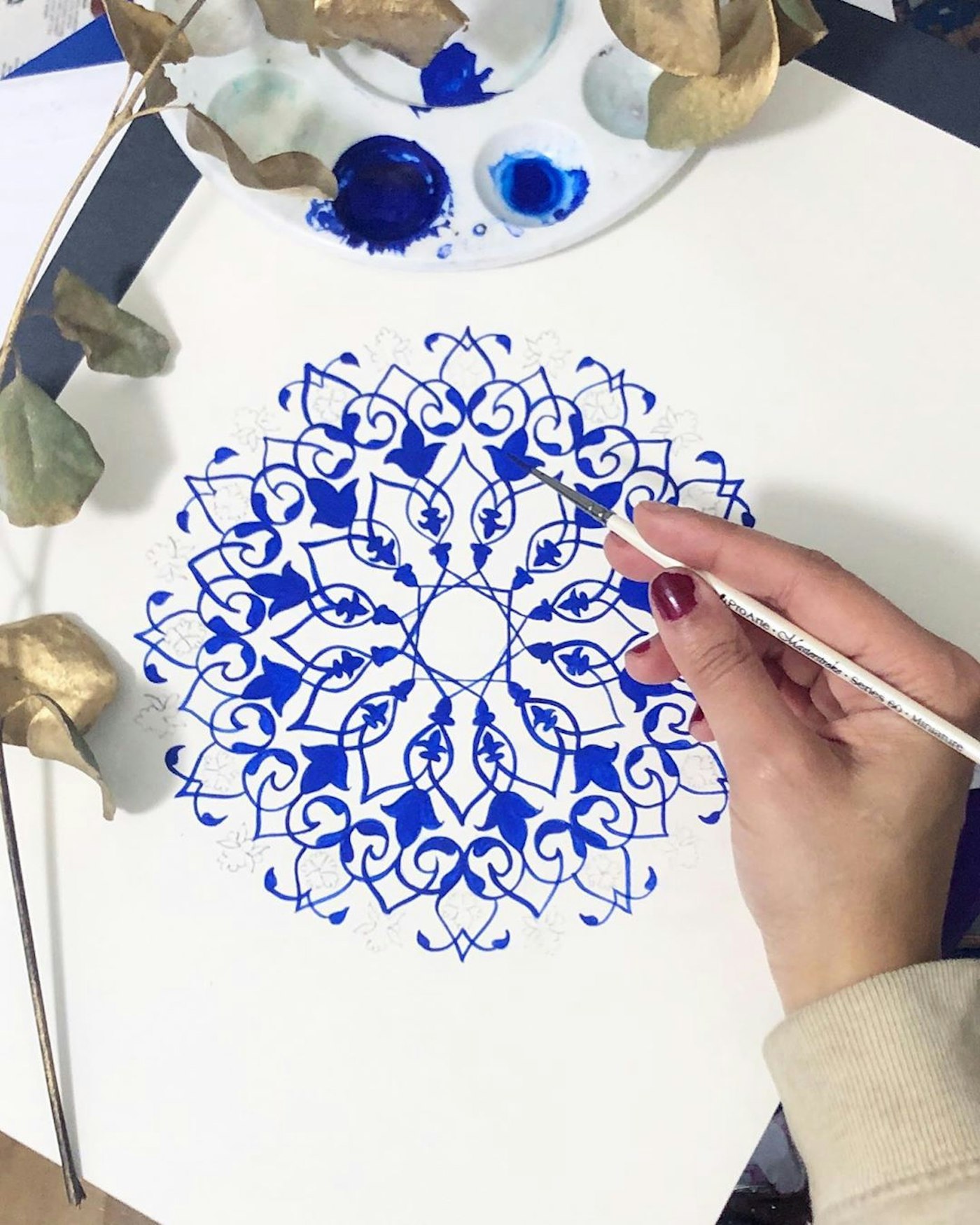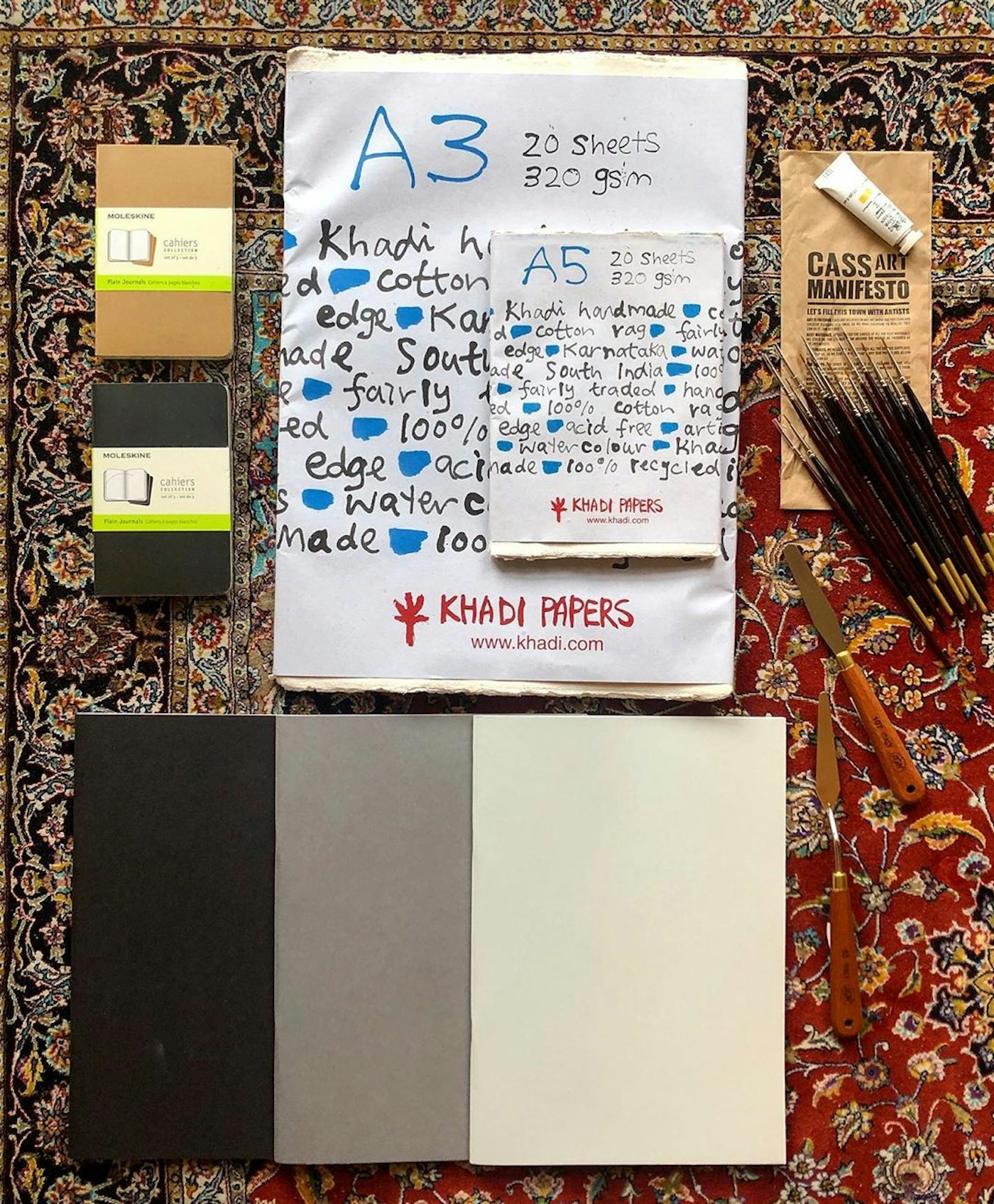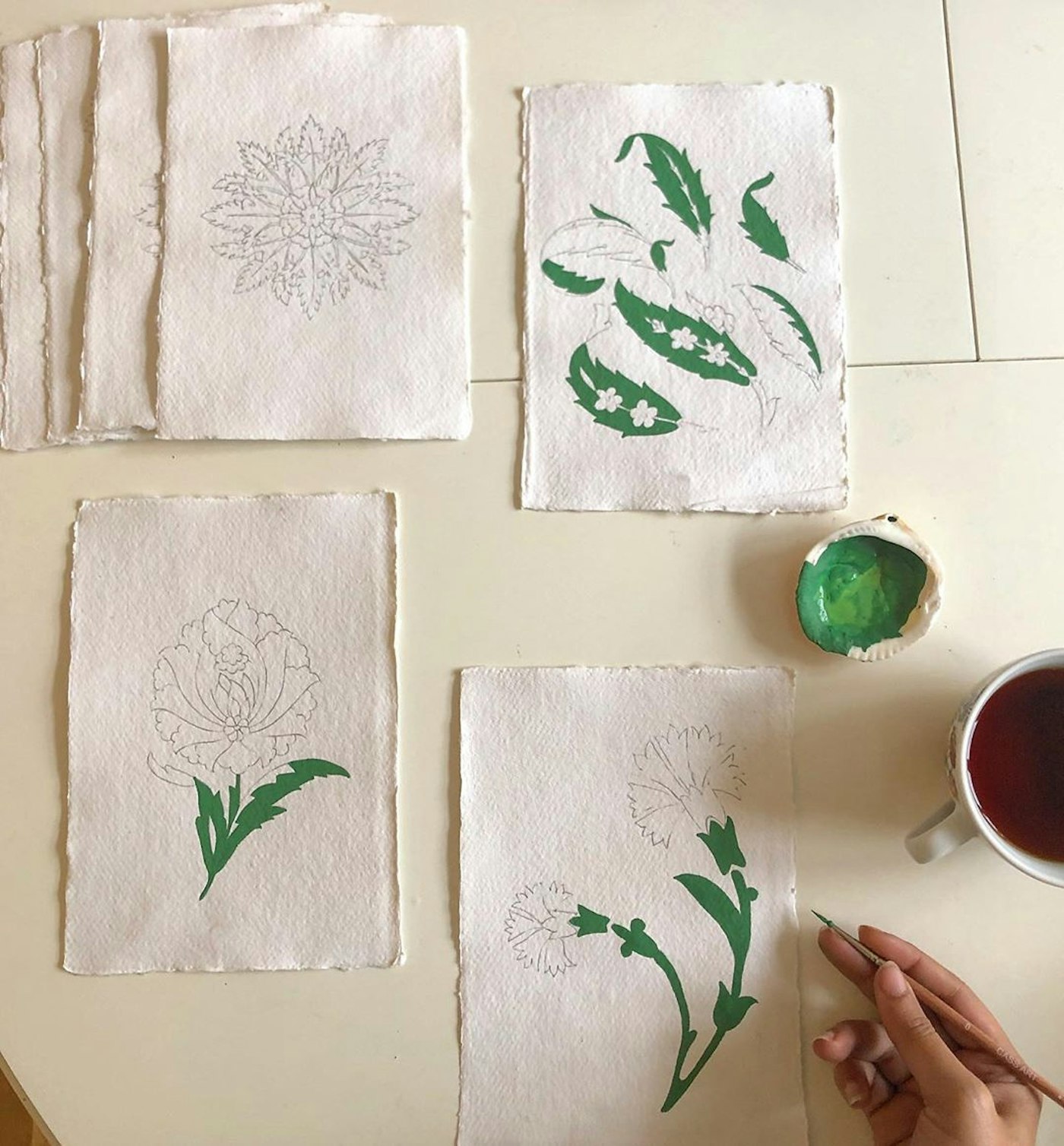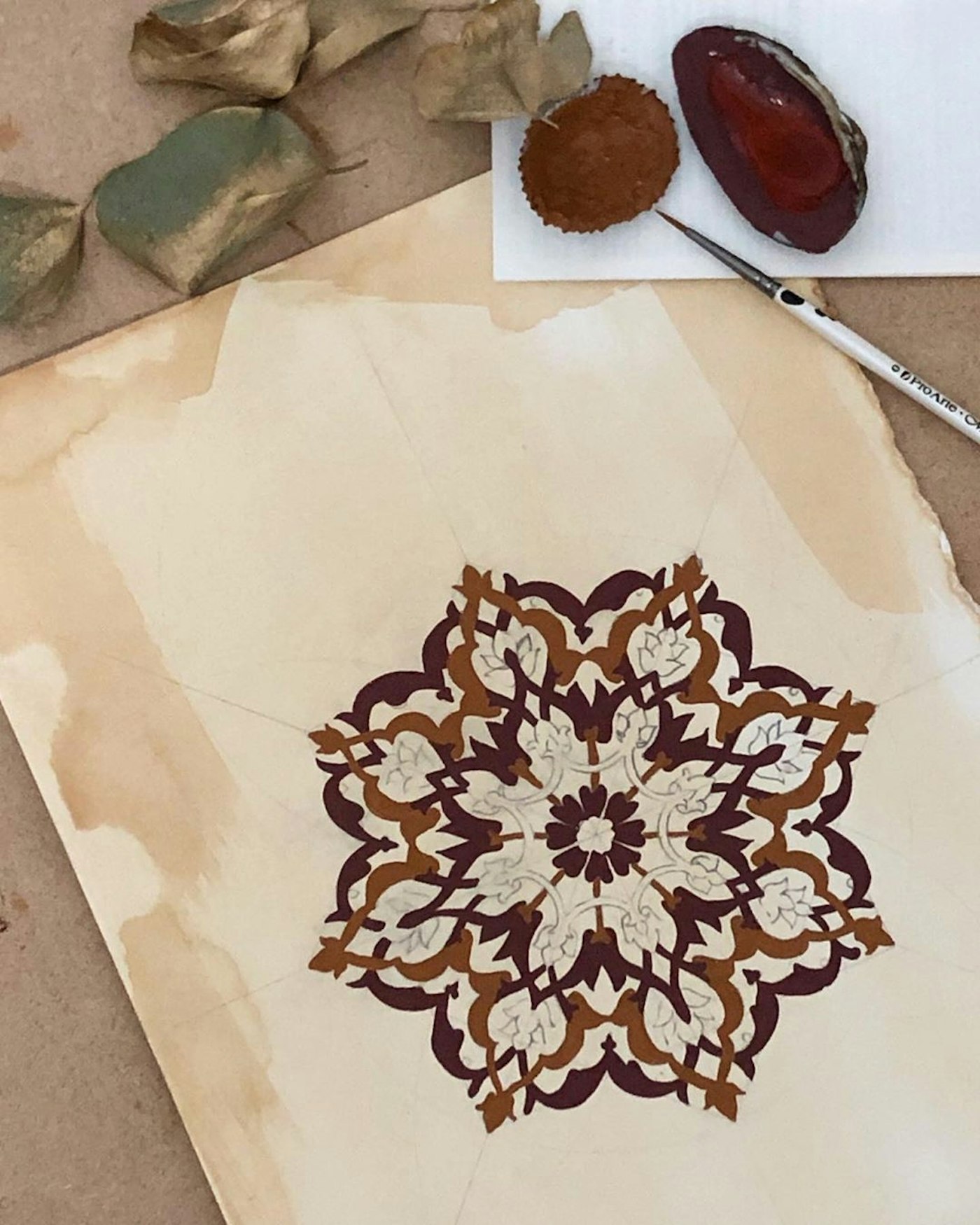Hustles + Hobbies: Islamic Illumination With Esra Alhamal
by Rosalind Marshall in Careers on 26th May, 2021

Image: IG @islamicillumination
At Amaliah, we’ve started a series talking to women who are championing the art of hobbies. We’ve spoken to Azeezat Adeola about mindfulness in knitting and how to get started and knitting for social issues, Neda about pole fitness, body confidence and online trolls, Chaimaa Creates about baking and cake design, Katie Haseeb about illustrating and fine arts, Brooke Benoit about jewellery design, Nur Hannah Wan about documentary-making and painting, Firdaws Clotaire about ceramics and pottery-making, and Zainab Alema about her journey to becoming a professional rugby player and encouraging more Muslim women to get involved in sports.
This time we’re talking to Esra Alhamal, a Saudi artist and academic who exhibits, runs workshops on Islamic Illumination, and hosts an art podcast; all whilst finishing her PhD in Architecture! I caught up with her to discuss her journey into Islamic art.
If you would like to interview a Muslim woman about her hobby, get in touch on contribute@amaliah.com
1. What’s the story behind how you got into Islamic art? When did you start and why?
I started during my Masters degree, which was in interior architecture. I’d recently moved to London and had to decide on what to do for my final project. Initially I had wanted to do it on tea as I love tea, but someone suggested I do it on Islamic Architecture. I was a bit taken aback, thinking “what stereotype is this!? Thinking I know anything about Islamic architecture!”, but then thought why don’t I?!

Image: IG @islamicillumination
So I Googled Islamic Patterns and found ‘Art of Islamic Pattern’ – run by Adam and Richard – and signed up to their classes. During the classes they kept talking about their trips abroad, and some of the people I had started following on Instagram were also talking about going on them. They had one going to Spain, and I’d always wanted to visit Spain to see Gaudi’s buildings in Barcelona. So I organised a trip to go to Granada, then onto Barcelona to see Gaudi, and then to meet some friends in Morocco where I saw all the Moroccan patterns.
During their classes, Adam and Richard had also mentioned the Prince’s School of Traditional Art. I did some research and found out about the Open Diploma, which you can get if you attend five classes at the school. I did a variety of classes to get the Diploma – arabesque, illumination, biomorphic patterns – and I really enjoyed the system of painting. I explored different areas, but it was illumination that really resonated with me.
I like that I can lose myself in the painting, in the moment by myself in my own thoughts and I wanted to do more of it!

Image: IG @islamicillumination
2. How did you manage to start, and grow, your practice first alongside your Masters and now your PhD?
After my Masters I wanted to work as a lecturer, but in the Academia world you can’t get promoted without a PhD. So I decided if I have to spend so many years doing a PhD, let me at least do it in something I’m really interested in. Because I was exploring Islamic art, let me make it relevant to what I’m studying, and because I like painting patterns, I want to make it relevant to biomorphic patterns as there’s already a lot of research into geometry.

Image: IG @islamicillumination
Both my art and my PhD are relevant to each other, so with the PhD I’m doing the history and with the art I’m doing the practical side. They are part of each other in a way!
3. What’s something that’s surprised you about Islamic art?
The whole process is surprising! I didn’t have any pre-determined ideas of what I wanted to do with it, and at first was just doing it to keep me busy. I found that my drawing style really fits with Islamic Art, as it’s so systematic. Anyone who understands the system can do it as the style is already established.

Image: IG @islamicillumination
4. What’s your favourite Illumination project been?
I really liked the circular (shamsa) patterns that are present in domes and ceilings. Two years ago I started taking those designs and translating it onto paper with my own understanding of shapes. I’m still playing with the idea today.
5. Do you set art goals? How do you pick your next project?
Ideas don’t stop between projects, so they’re always in my mind. And the most random thing could ignite an idea: even mundane everyday things or phrases. I’m really good at keeping lists, and have a list of art ideas. And ideas often join together and form a collection. Time often dictates which project I do. At the moment I have to do smaller projects, as that’s all my time allows at the moment.

Image: IG @IslamicIllumination
6. For anyone that’s been inspired and would like to get started, how and where do they start?
It’s really important to allow yourself to explore things that you think you like. Watch some videos and tutorials. If you like it, read around it or find a class to go along to.
A lot of the artists have resources available. For example I have a resource page on my website Islamicillumination.com where I outline what books I recommend and what things I do. Its best not to message the artists directly on social media asking where to start, as many of us have already made the information readily available on our sites. However, do look at their projects and sign up to their courses. There’s Art of Islamic Pattern for geometry, which are held in London and abroad. Samira Mian also runs online and courses in London for geometry, and I run online and in-person courses on illumination.
7. You’ve recently started an art podcast; can you tell us a bit more about that?
I’ve been listening to podcasts whilst doing my artwork as it’s so time-consuming – that way I feel extra-productive! I was looking for specific art ones to improve my knowledge, however I could only find ones on abstract or life drawing. I didn’t feel like there were any on traditional practice and felt there was a need for it. People around me were really encouraging, I like talking, and I wanted to step away from video content as I found it could be quite judgmental. I’m also in a very fortunate position in that I’m based in London, where there are so many amazing artists and in touch with a whole circle of artists whom I would love to feature – both in traditional art, and from the MENA region.
I’ve had so many amazing messages from people finding it really useful, and providing them with access to information that it was difficult to source.
8. I love all your episodes so far, and love that you’re expanding into this new area. Are there other hobbies you pursue or would like to in the future?
Oh my gosh, so many! I’d love to be able to make my own ethical clothing, but also want to get more into painting pottery and ceramics. I’d love to do some tiles with the Islamic influences. I’m also really into pigments at the moment, and want to learn more about tempera paint, as well as more botanical and floral illustrations. Literally everything; there’s not enough time in life!
I’d like to thank Esra for taking some time out of her busy schedule to talk about her work and journey. As mentioned during the interview, Esra has a wealth of resources available on her website www.islamicillumination.com, and you can find out more about Islamic art and artists on her ‘Art Illuminated’ podcast, which is available on all major platforms. She not only runs regular workshops in London, but also has an online course available that you can access through her website. You may also follow her on Instagram @islamicillumination.
If you would like to interview a Muslim woman about her hobby, get in touch on contribute@amaliah.com
Rosalind Marshall
Rosalind Marshall is an Australia-based doctor training towards her GP Fellowship. She is an enthusiastic proponent of traditional arts and crafts, and is currently studying for her Masters in Classical Arabic and Islamic Studies at the Islamic Sciences & Research Academy Australia. You may follow her on Instagram @roehsah